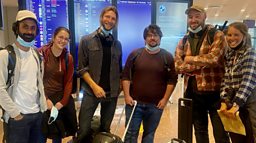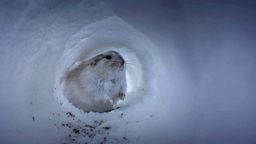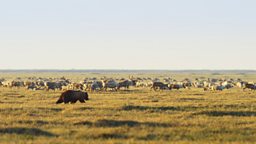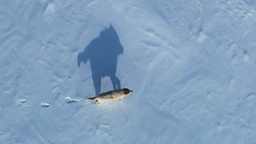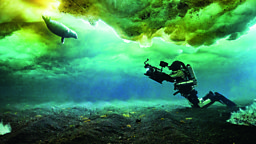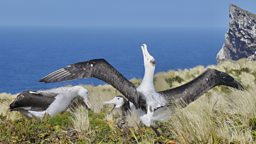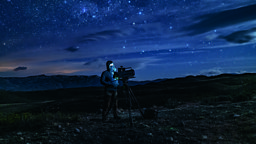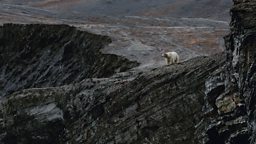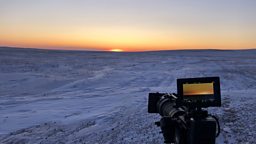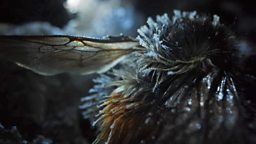Queen of the Arctic
By Yoland Bosiger, Assistant Producer for Frozen Planet II

one story that was so surprising even Sir David Attenborough hadn’t heard of it
The Arctic tundra is one of the last true wildernesses on Earth – a vast northern land of extremes where, in the darkness of winter, temperatures may plummet to -50°C, while in summer, the land (though still cool) bathes in 24-hour sunlight. Conditions are so tough that only a heroic cast of animals can survive here year-round. Some, like the Arctic fox and lemming, may be familiar, but there was one story of survival so surprising, that even Sir David Attenborough hadn’t heard of it. To attempt to film this story, it required support from scientists, a dedicated crew and the latest camera technology. It was the story of the tiny Lapland bumblebee.

just a few weeks in spring to feed, make a nest and raise an entire family!
Initially, it might look similar to a bumblebee from Britain, but there are a few crucial differences that set this bee apart. Lapland bumblebee queens found in Arctic Sweden are considerably bigger and furrier than their southerly relatives and can tolerate freezing temperatures down to -20°C. They hibernate through winter for nine months – which gives them just a few weeks in spring to feed, make a nest and raise an entire family! So gruelling is this challenge that only 50% of Lapland bumblebee queens will survive into the following winter.
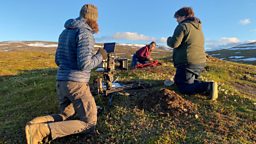
A task which was only possible with the help of two groups of expert scientists
To stand a chance of filming the Lapland bumblebee queen, Producer Jane Atkins sent episode researcher Premdeep Gill and I to Abisko in Arctic Sweden. Our plan was to film the unseen story of the Lapland bumblebee queen creating a nest and raising a family as soon as the icy grip of winter passed. A task which was only possible with the help of two groups of expert scientists who joined the ���˿��� team on location – Prof. Pierre Rasmont, Dr. Baptiste Martinet, Kimberly Przybyla and Dimitri Evrard from the University of Mons and Richard Gill from Imperial College London. Both groups studied Arctic bumblebees and were also interested in observing and understanding more about this little-known species.
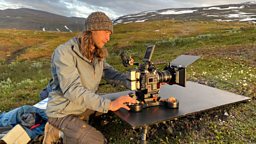
how to find one species of tiny insect amidst such a vast expanse of Arctic tundra still frozen solid?
The first task for the camera team was to film the queen feeding on nectar and pollen in the wild. But how to find one species of tiny insect amidst such a vast expanse of Arctic tundra still frozen solid? Enter the science team. They began scouring the landscape on foot, and before long, their well-trained eyes spotted the first Lapland bumblebee queen foraging on her favourite spring flowers. The problem then was to film the queen flying. Bumblebees can beat their wings extremely fast – around 200 times a second! So Joris van Alphen’s solution was to use a high-speed camera to slow down the action - revealing intricate and complex behaviour impossible to see with the human eye.
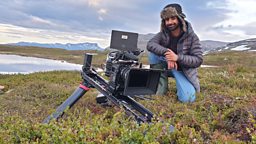
a specialised low-light camera to see the invisible
But the biggest challenge of this shoot was filming inside the nest where the dedicated queen worked tirelessly to incubate her brood. The team were fortunate enough to find the queen’s nest – hidden away in the shallow soil in what used to be a lemming burrow. Inside the nest was pitch black and needed to be, so the queen felt safe and undisturbed as she tended her eggs. To stand a chance of filming this behaviour in near total darkness, Garath Whyte worked alongside the scientists and used a specialised low-light camera to see the invisible. But nobody knew if this innovative technology would pay off, it took three weeks of patiently waiting before the queen finally rewarded the team with the emergence of her first baby worker bee.
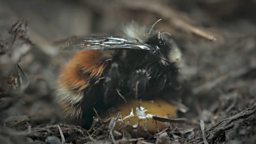
The greatest achievement of the Frozen Lands team on this particular story was the contribution to the scientific literature
The greatest achievement of the Frozen Lands team on this particular story was the contribution to the scientific literature. The observations of the queen breeding gave new insight into her nesting behaviour. An exciting finding for Pierre’s team was the queen’s active participation in incubation – she covered her whole brood with her large body, vibrating her flight muscles to keep them warm, not unlike a bird incubating its nest. The nest also included an enormous tubular honey pot that Pierre had never seen before in any bumblebee species. The filming collaboration and hard work of the scientists culminated in published early this year.
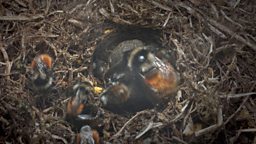
The star, for me, was that Lapland Queen. I had never heard of her before. And watching her provide sweet drinks for the kids, I thought quite charming.Sir David Attenborough
It was the first time anyone had filmed the extraordinary story of bumblebees surviving in the Arctic, emerging from hibernation and busily creating new life during the short Arctic spring. For Sir David Attenborough, the bee was a personal favourite of his. He wrote, ‘The star, for me, was that Lapland Queen. I had never heard of her before. And watching her provide sweet drinks for the kids, I thought quite charming.’
